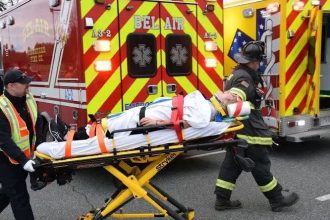Early Sunday morning in Natchez, Miss., a sudden thunderstorm brought more than heavy rain—it brought heartbreak. Around 2:30 a.m., emergency calls flooded in about a woman who had fallen into a storm‐drain under maintenance at the intersection of Aldrich Street and Brenham Avenue. Witnesses say two people walking in the downpour lost footing: one climbed out and phoned for help, while 42-year-old Lashonda Dixon was swept away by the rising waters before rescuers could reach her.
When first‐responders arrived, Dixon was unresponsive. Police Chief Cal Green confirmed the scene: “Two who fell in… one got out, the other was swept away,” he said quietly. Inside the compromised drain beneath the roaring storm, firefighters led by Chief Robert Arrington faced a nightmare scenario: they broke apart concrete around a manhole to insert tools into the underground system, battling darkness, rushing water, and danger at every turn. “It was a job to get her out,” Arrington said later.



After what authorities describe as an intense and harrowing search, Dixon’s body was recovered about 20 feet from the point where she fell in. Emergency crews say the stormwater currents carried her away—and even extraction of her was challenged by the infrastructure work underway. The investigation into the exact cause of her death—whether the fall, the drowning, or both—remains open, Chief Green said.
For the tight‐knit Natchez community, the shock is deep. Friends and neighbors remembered her as a kind, joyful soul who always put family and others first. In the hours after, memorials sprung up near the scene of the tragedy: candles, flowers, handwritten notes of grief and love placed where the storm swallowed one of their own. The official obituary lists her full name as LaShonda Renee Dixon-Terrell, born January 3, 1983, passing October 26, 2025 at age 42.
City officials say they will now review safety measures, especially around storm‐drain openings and maintenance zones during inclement weather. With multiple stormwater projects already under way in Natchez, this incident has prompted new urgency around drainage signage, barricades, and public alerts in construction areas. Chief Green stressed the need for “a thorough evaluation” so that such a tragedy does not happen again.
But this moment is less about protocols and more about loss: a woman’s life cut short, a family left with a silence too heavy. Dixon’s memory will live in smiling recollections, in the ripple of vigils beside that storm-drain, and in the community’s resolve to make the city safer—for everyone walking home in the dark of a storm.
In the end, Natchez mourns—not just over a mechanism of decay and concrete, but over a human being who slipped between the cracks of a night that was supposed to wash away troubles. And now, in the stillness that follows the storm, one beloved resident is gone far too soon.



